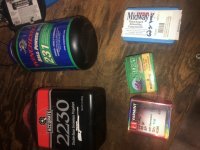Hi all. I have multiple thoughts and questions. I am sure some of this may be redundant, but some I feel are specific to me or may not come up in more general queries. I am comfortable loading 9mm for pistol on my Lee Classic Turret press. I have only loaded a few boxes and am working things out, what works what doesn't having to do mostly with my process.
I am going to start loading 5.56/.223 for 3 different rifles. I intend to develop a load for each rifle. After that I will load for my Garand. One is an AR carbine that as long as is combat accurate will be fine. My CZ 527 and RR National Match I will eventually be going after accuracy. Likely extremely good eventually as I plan to get into NRA Hi Power with the RR. I understand that much more will be revealed there! With that basis here are my questions:
1. As far as random mixed range brass how to do you sort and group them? I know by head stamp, but also do you go by case weight and volume? I also have some chamber formed brass from my rifles which I know will be best. I plan to use a collet die on those and fully resize any random brass until it has been fired in my rifles. How extreme do you get as far as good enough for plinking, accurate and match accurate?
2. Recommend a Chronograph please
3. Recommend a Spotting Scope please. For now one for my development. Ill worry about Hi Power when I get there.
4. With the plethora of powders, bullets and loads out that do you just search on what people are using in their rifles as a starting point? Verified in loading books of course.
5. I am assuming best to focus on one rifle at a time?
6. What do you guy do to load at the range if you can?
7. I know I can load rifle on the Turret press but I have read a lot about the benefits of a single stage for it. Anything to it? Seems like more precision is possible maybe. Can I stick with Lee for that since I already have dies and all kinds of stuff that I like.
Thank you all so much. I am sure I will have more, but that will do it for now. Thanks again.
I am going to start loading 5.56/.223 for 3 different rifles. I intend to develop a load for each rifle. After that I will load for my Garand. One is an AR carbine that as long as is combat accurate will be fine. My CZ 527 and RR National Match I will eventually be going after accuracy. Likely extremely good eventually as I plan to get into NRA Hi Power with the RR. I understand that much more will be revealed there! With that basis here are my questions:
1. As far as random mixed range brass how to do you sort and group them? I know by head stamp, but also do you go by case weight and volume? I also have some chamber formed brass from my rifles which I know will be best. I plan to use a collet die on those and fully resize any random brass until it has been fired in my rifles. How extreme do you get as far as good enough for plinking, accurate and match accurate?
2. Recommend a Chronograph please
3. Recommend a Spotting Scope please. For now one for my development. Ill worry about Hi Power when I get there.
4. With the plethora of powders, bullets and loads out that do you just search on what people are using in their rifles as a starting point? Verified in loading books of course.
5. I am assuming best to focus on one rifle at a time?
6. What do you guy do to load at the range if you can?
7. I know I can load rifle on the Turret press but I have read a lot about the benefits of a single stage for it. Anything to it? Seems like more precision is possible maybe. Can I stick with Lee for that since I already have dies and all kinds of stuff that I like.
Thank you all so much. I am sure I will have more, but that will do it for now. Thanks again.

